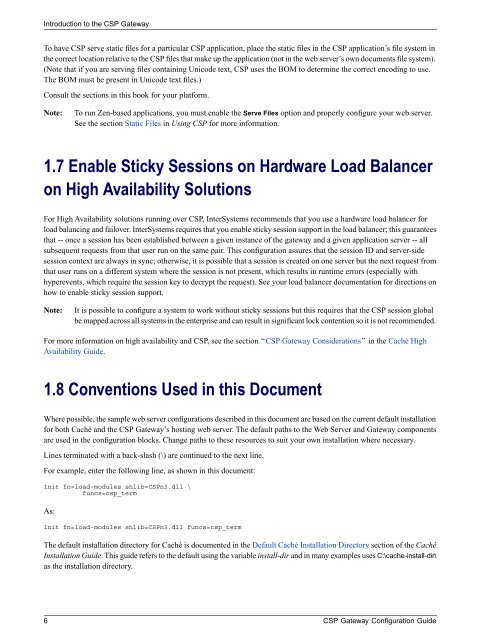CSP Gateway Configuration Guide - InterSystems Documentation
CSP Gateway Configuration Guide - InterSystems Documentation
CSP Gateway Configuration Guide - InterSystems Documentation
You also want an ePaper? Increase the reach of your titles
YUMPU automatically turns print PDFs into web optimized ePapers that Google loves.
Introduction to the <strong>CSP</strong> <strong>Gateway</strong><br />
To have <strong>CSP</strong> serve static files for a particular <strong>CSP</strong> application, place the static files in the <strong>CSP</strong> application’s file system in<br />
the correct location relative to the <strong>CSP</strong> files that make up the application (not in the web server’s own documents file system).<br />
(Note that if you are serving files containing Unicode text, <strong>CSP</strong> uses the BOM to determine the correct encoding to use.<br />
The BOM must be present in Unicode text files.)<br />
Consult the sections in this book for your platform.<br />
Note:<br />
To run Zen-based applications, you must enable the Serve Files option and properly configure your web server.<br />
See the section Static Files in Using <strong>CSP</strong> for more information.<br />
1.7 Enable Sticky Sessions on Hardware Load Balancer<br />
on High Availability Solutions<br />
For High Availability solutions running over <strong>CSP</strong>, <strong>InterSystems</strong> recommends that you use a hardware load balancer for<br />
load balancing and failover. <strong>InterSystems</strong> requires that you enable sticky session support in the load balancer; this guarantees<br />
that -- once a session has been established between a given instance of the gateway and a given application server -- all<br />
subsequent requests from that user run on the same pair. This configuration assures that the session ID and server-side<br />
session context are always in sync; otherwise, it is possible that a session is created on one server but the next request from<br />
that user runs on a different system where the session is not present, which results in runtime errors (especially with<br />
hyperevents, which require the session key to decrypt the request). See your load balancer documentation for directions on<br />
how to enable sticky session support.<br />
Note:<br />
It is possible to configure a system to work without sticky sessions but this requires that the <strong>CSP</strong> session global<br />
be mapped across all systems in the enterprise and can result in significant lock contention so it is not recommended.<br />
For more information on high availability and <strong>CSP</strong>, see the section “<strong>CSP</strong> <strong>Gateway</strong> Considerations” in the Caché High<br />
Availability <strong>Guide</strong>.<br />
1.8 Conventions Used in this Document<br />
Where possible, the sample web server configurations described in this document are based on the current default installation<br />
for both Caché and the <strong>CSP</strong> <strong>Gateway</strong>’s hosting web server. The default paths to the Web Server and <strong>Gateway</strong> components<br />
are used in the configuration blocks. Change paths to these resources to suit your own installation where necessary.<br />
Lines terminated with a back-slash (\) are continued to the next line.<br />
For example, enter the following line, as shown in this document:<br />
Init fn=load-modules shlib=<strong>CSP</strong>n3.dll \<br />
funcs=csp_term<br />
As:<br />
Init fn=load-modules shlib=<strong>CSP</strong>n3.dll funcs=csp_term<br />
The default installation directory for Caché is documented in the Default Caché Installation Directory section of the Caché<br />
Installation <strong>Guide</strong>. This guide refers to the default using the variable install-dir and in many examples uses C:\cache-install-dir\<br />
as the installation directory.<br />
6 <strong>CSP</strong> <strong>Gateway</strong> <strong>Configuration</strong> <strong>Guide</strong>

















